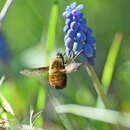fr
noms dans le fil d’Ariane


Der Gefleckte Wollschweber (Bombylius discolor) ist eine Insektenart aus der Familie der Wollschweber und überwiegend in Europa verbreitet.
Die Körperlänge beträgt 10–16 mm. Der nach vorne stehende Saugrüssel kann bis zu 10 mm lang werden. Der gedrungene Körper ist mit einer braunen und schwarzen, dichten Behaarung besetzt. Die Unterseite und der hintere Teil des Abdomens sind dunkel behaart. Der Habitus erinnert an Hummeln, Wollschweber gehören aber zu den Fliegen. Auf den sonst transparenten Flügeln befinden sich schwarze Flecken, die der Art ihren Namen gegeben haben. Der Vorderrand der Flügel ist verdunkelt. Der Standflug („auf der Stelle fliegen“) der Art erinnert an Schwebfliegen. Durch die langen, dünnen Beine lassen sich Wollschweber gut von Bienen unterscheiden, außerdem haben sie nur zwei Flügel, da die Hinterflügel wie bei allen Zweiflüglern zu Halteren umgeformt sind.
Eine ähnliche Art ist der Große Wollschweber, der jedoch kleiner ist und keine Flecken auf den Flügeln aufweist. Eine weitere ähnliche Art stellt Bombylius medius dar. Diese besitzt ebenfalls gefleckte Flügel, ist jedoch auf der Unterseite und dem Hinterrand des Abdomens hell behaart.
Die Art ist weit verbreitet in Mittel-, Süd- und Osteuropa und kommt überdies auch in Westasien und Nordafrika vor. In Kalifornien wurde die Art eingeschleppt. Die nördlichsten Vorkommen liegen im Süden von Großbritannien, in Belgien, den Niederlanden und Mitteldeutschland, nördlich bis in die südlichen Bereiche des Norddeutschen Tieflands. Im Westen des Verbreitungsgebietes kommt die Art außerdem auf der Iberischen Halbinsel, in Marokko, Frankreich, der Schweiz und Italien vor. Weiter östlich findet sie sich in Österreich, der Slowakei und südlich davon auf der Balkanhalbinsel bis in die westliche Türkei. In Nordosteuropa gibt es außerdem Nachweise aus Estland, Litauen, der Ukraine und Russland, östlich bis etwas über die Wolga hinaus.[1]
Die Art findet sich in Kulturland, an Weg- und Waldrändern, in Laubwäldern, Steinbrüchen, Gärten und Macchie. Bevorzugt werden offene Landschaften mit trockenen Böden, in denen verschiedene Bienenarten ihre Nester bauen und ein Angebot an nektarhaltigen Pflanzen vorhanden ist.
Zwischen April und Juni kann man adulte Exemplare häufig dabei beobachten, wie sie auf der Suche nach Nektar Blüten anfliegen. Weibchen tarnen ihre Eier mit Sand und legen diese an den Nestern von solitären Bienenarten ab. Die schlüpfenden Larven suchen das Innere der Nester auf und ernähren sich dann parasitoid von den Bienenlarven. Zu den Wirtsarten ist wenig bekannt, vermutlich werden aber unter anderem Sandbienen parasitiert, wie die Gemeine Sandbiene und die Graue Sandbiene. Auch über die Nahrungspflanzen der Art ist wenig bekannt, Nachweise gibt es aber für Primeln, Vergissmeinnicht und Blaukissen.[2]
Der Gefleckte Wollschweber (Bombylius discolor) ist eine Insektenart aus der Familie der Wollschweber und überwiegend in Europa verbreitet.
Bombylius discolor is a Palearctic species of fly in the family Bombyliidae. [1][2][3]
Bombylius discolor is a Palearctic species of fly in the family Bombyliidae.
Bombylius discolor adalah spesies lalat yang berasal dari genus Bombylius dan famili Bombyliidae. Lalat ini juga merupakan bagian dari ordo Diptera, kelas Insecta, filum Arthropoda, dan kingdom Animalia.
Lalat ini biasanya memakan nektar dan polen yang ada dalam bunga.
Bombylius discolor adalah spesies lalat yang berasal dari genus Bombylius dan famili Bombyliidae. Lalat ini juga merupakan bagian dari ordo Diptera, kelas Insecta, filum Arthropoda, dan kingdom Animalia.
Lalat ini biasanya memakan nektar dan polen yang ada dalam bunga.
De gevlekte wolzwever (Bombylius discolor) is een vliegensoort uit de familie van de wolzwevers (Bombyliidae).[1] De wetenschappelijke naam van de soort is voor het eerst geldig gepubliceerd in 1796 door Mikan.
De larven leven in de nesten van zandbijen[2]. Het eileggedrag is karakteristiek voor het geslacht Bombylius. De vrouwtjes vullen eerst de zandkamer met zand om de eitjes minder kleverig te maken. Het vrouwtje vliegt laag over de grond op zoek naar een nestingang van een zandbij. Als er een nestingang gevonden is gaat het vrouwtje ervoor zweven en schiet met een slingerbeweging van het achterlijf een ei in het gat[3][4].
http://insect-behavior.nl/bombylidae
Bronnen, noten en/of referentiesDe gevlekte wolzwever (Bombylius discolor) is een vliegensoort uit de familie van de wolzwevers (Bombyliidae). De wetenschappelijke naam van de soort is voor het eerst geldig gepubliceerd in 1796 door Mikan.